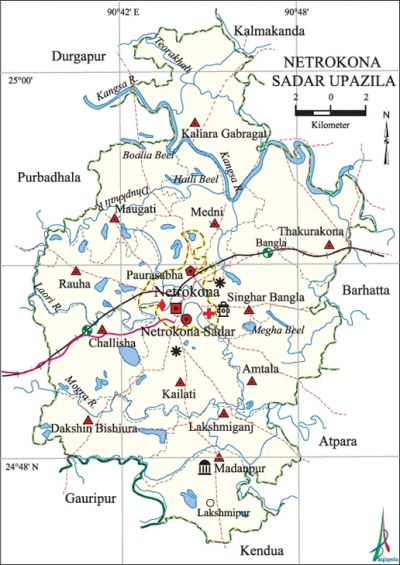Netrokona Sadar Upazila
Netrokona Sadar Upazila (netrokona district) area 340.35 sq km, located in between 24°47' and 24°58' north latitudes and in between 90°38' and 90°50' east longitudes. It is bounded by durgapur (Netrokona) and kalmakanda upazilas on the north, kendua and gauripur upazilas on the south, barhatta and atpara upazilas on the east, purbadhala upazila on the west.
Population Total 329732; male 168822, female 160910; Muslim 296860, Hindu 32320, Buddhist 102, Christian 21 and others 429.
Water bodies Main rivers: kangsa, Teorkhali, Dhupikhali, Laori, Mogra; 'Boalia Beel, Hatli Beel, Megha Beel are notable.
Administration Netrokona Thana was formed in 1874 and it was turned into an upazila in 1983. '
| Upazila | ||||||||
| Municipality | Union | Mouza | Village | Population | Density (per sq km) | Literacy rate (%) | ||
| Urban | Rural | Urban | Rural | |||||
|
1 |
12 |
275 |
343 |
56786 |
272946 |
969 |
66.5 |
39.9 |
| Municipality | ||||||||
|
Area (sq km) |
Ward |
Mahalla |
Population |
Density |
Literacy rate (%) | |||
|
21.11 |
9 |
33 |
56786 |
2690 |
66.5 | |||
| Union | ||||
| Name of union and GO code | Area (acre) | Population | Literacy rate (%) | |
| Male | Female | |||
|
Amtala 13 |
6589 |
10677 |
10587 |
35.74 |
|
Kailati 31 |
6658 |
16159 |
14859 |
56.00 |
|
Kaliara Gabragat 39 |
9519 |
13487 |
13012 |
28.80 |
|
Challisha 15 |
6337 |
11539 |
11209 |
49.70 |
|
Thakurakona 94 |
7549 |
12134 |
11569 |
46.71 |
|
Dakshin Bishiura 23 |
5570 |
9382 |
9129 |
32.90 |
|
Madanpur 54 |
5443 |
9781 |
9774 |
36.36 |
|
Medni 55 |
6180 |
12581 |
12072 |
36.37 |
|
Maugati 63 |
6831 |
10966 |
10341 |
35.33 |
|
Rauha 79 |
6389 |
12367 |
11665 |
40.11 |
|
Lakshmiganj 47 |
5471 |
8831 |
8686 |
33.85 |
|
Singhar Bangla 87 |
6377 |
11303 |
10836 |
37.98 |
Source Bangladesh Population Census 2001, Bangladesh Bureau of Statistics.

Archaeological heritage and relics tomb of Hazrat Shah Sultan Kamruddin Rumi (R) at Madanpur.
Historical events On 15 March 1939 Netaji subhas chandra bose addressed in a public meeting held at the Methar Patti (sweeper colony) playground. The All India Peasant Conference was held during 8, 9, and 10 April 1945 at the Parar Playground of Netrokona. On 29 April 1971, the Pak army captured 4 persons of Netrokona sadar and shot them dead at the Trimohani bridge on the Purbadhala Road. Three freedom fighters were killed in an encounter with the Pak army on 9 December at Netrokona sadar. In another encounter between the freedom fighters and the Pak army at the Agricultural Farm the Pak army was defeated; in this encounter two freedom fighters were killed.
Marks of the War of Liberation Memorial monument 3.
Religious institutions Mosque 315, temple 35, tomb 5.
Literacy rate and educational institutions Average literacy 44.8%; male 48%, female 41.5%. Educational institutions: college 5, law college 1, homeopathy college 1, primary teachers training institute 1, polytechnic institute 1, secondary school 35, primary school 220, ngo school 120, madrasa 37. Noted educational institutions: Netrokona Government College, Netrokona Datta High School (1889), Chandranath High School (1909), Anjuman High School (1914), Netrokona Girls' High School (1969).
Newspapers and periodicals Daily: Jananetra, Banglar Darpan, Deshkanthaswar; weekly: Muktir Pratik.
Cultural organisations Library 3, cinema hall 2, playground 15, theatre stage 1, theatre group 10, jatra party 8, community centre 12.
Main sources of income Agriculture 60.03%, non-agricultural labourer 4.18%, industry 0.78%, commerce 13.51%, transport and communication 4.44%, service 7.18%, construction 1.62%, religious service 0.19%, rent and remittance 0.29% and others 7.78%.
Ownership of agricultural land Landowner 56.19%, landless 43.81%; agricultural landowner: urban 45.84% and rural 58.24%.'
Main crops Paddy, jute, maize.
Extinct or nearly extinct crops Pulse.
Main fruits Mango, jackfruit, blackberry.
Fisheries, dairies and poultries Fishery 20, dairy 10, poultry 35.
Extinct or nearly extinct traditional transport Palanquin, bullock cart, buffalo cart.
Noted manufactories Ice factory, flour mill, saw mill, printing press, welding factory, bidi factory.
Cottage industries Goldsmith, blacksmith, potteries, embroidery, wood work.
Hats, bazars and fairs Hats and bazars are 60, fairs 3, most noted of which are Thakurakona Hat, Chuchua Hat, Hatkhola Bazar, Shimulkandi Bazar, Challisha Bazar, Dakshin Bisiura Bazar, Madanpur Bazar, Lakshmiganj Bazar, Amtala Bazar; Paush Mela at Madanpur, Baul Mela at Netrokona Town.
Main exports Paddy, jute.
Access to electricity All the wards and unions of the upazila are under rural electrification net-work. However 23.90%' of the dwelling households have access to electricity.
Sources of drinking water Tube-well 93.97%, tap 1.02%, pond 0.61% and others 5.10%. The presence of arsenic has been detected in shallow tube-well water of the upazila.
Sanitation 26.63% (rural 17.10% and urban 74.68%) of dwelling households of the upazila use sanitary latrines and 46.05% (rural 51.46% and urban 18.78%) of dwelling households use non-sanitary latrines; 27.32% of households do not have latrine facilities.
Health centres Hospital 1, satellite clinic 3, health and family welfare centre 12, clinic 2.
NGO activities Operationally important NGOs are brac, caritas, proshika, asa, Gonoshahajjo Sangstha, Nari Pragati Sangha. [Syed Marufuzzaman]
'References Bangladesh Population Census 2001, Bangladesh Bureau of Statistics; Cultural survey report of Netrokona Sadar Upazila 2007.
